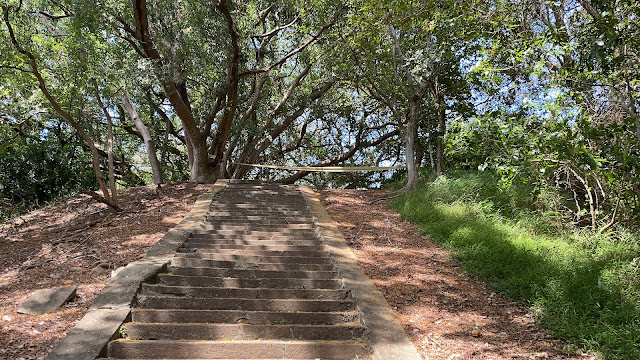Scrolling through Google Maps to find some interesting places to visit, I found one very close to where we live: Qiding Shrine in Zhunan Town. The shrine is on the grounds of the Animal Medicinal Experimental Institute. Although Google Maps directs you to the entrance of the institute, you won't be able to enter from there. Instead, follow the institute's fence all the way to the end. There, you will see a path. It may not be easily visible, but it's there.
The path looks a bit creepy, and I wouldn't have dared to go alone, but I brought my husband and son with me, so we all went in. There is a Japanese-style building, but it's impossible to get a closer look as it's inside the institute's grounds. The path goes among trees with roots hanging down. If nobody had been there for a long time, the trail might not even be visible. As you follow the trail, you will see many signs warning not to get close to the fence.
After a while, the stairs become visible. The stairs are in poor condition, but we followed them all the way up. Unfortunately, due to tree disease, the area is covered with tape. It's still possible to get closer, though you should be careful as the trees may easily collapse. Right behind the little shrine, one of the trees had fallen. I quickly took some close-up pictures but didn't walk around any more due to the danger.
Visiting Qiding Shrine was an unexpected adventure. While the path to the shrine is not for the faint of heart and caution is advised due to the condition of the trees, it offers a unique glimpse into the past. If you're up for a bit of a thrill and appreciate hidden historical gems, Qiding Shrine is a worthwhile destination. Just make sure to bring company for safety and a sense of shared discovery.
Qiding Shrine (崎頂日出神社遺址)
Nestled on a hill behind the Animal Medicinal Experimental Institute in Zhunan Town, Miaoli County, lie the evocative ruins of Qiding Shrine. This site, a remnant of the Japanese colonial period in Taiwan, was once part of the Hsinchu State Agricultural Research Institute.
Constructed in 1934, Sakiide Shrine, later known as Nichu Shrine due to its eastward orientation towards the rising sun, was dedicated to the deities Amaterasu and Toyouke. Today, only fragments of its past grandeur remain, including a cement pedestal, a pair of small stone lanterns, the shrine stairs, and the base of the torii gate.
The trail leading to the shrine is obscured and unmarked, with only a faint path visible near the laboratory's iron fence. Along this hidden trail, ancient fig trees drape like curtains, and aged trees with abundant branches add to the sense of history. As one progresses, the shrine stairs become visible, flanked by three majestic old banyan trees at the base. Atop the pedestal, Ksitigarbha Bodhisattva is now enshrined, honoring the souls of animals once used in experiments.
Despite its dismantling, the shrine's outline, two staircases, stone lanterns, and the base of the torii gate remain. Reflecting its association with the Agricultural Extension School, the shrine is relatively small compared to others. Despite its historical significance, the site is well-maintained by the institute, ensuring the preservation of this cultural treasure.
Address:
350苗栗縣竹南鎮350崎頂日出神社遺址



















Thank you for posting this. I've visited many old Shinto shrines in Taiwan, but I wasn't aware of this one.
ReplyDelete